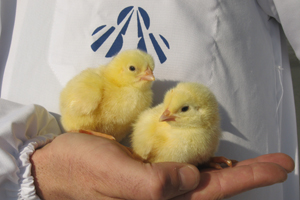HACCP and feed additive measure to control Salmonella

For poultry meat producers it has been mandatory to provide Salmonella-free fresh poultry meat from 1 December 2011. In addition the EU directive 2160/2003 aims to reduce levels in poultry and prescribes a target for maximum Salmonella levels in broilers, layers and turkeys. Dutch feed additive producer, Selko and poultry processor SADA in Spain joined forces to tackle the problem of Salmonella contamination.
By Dick Ziggers
Selko Feed Additives, an expert on Salmonella control, joined forces with Grupo SADA since 2008 to improve the existing Salmonella control programme (Figure 1) for the animal production chain. Grupo SADA, Nutreco’s poultry division in Spain, focuses its activities on the complete management of the entire chicken meat production cycle, from grandparent stock, hatcheries, broiler farms and processing plants, to the distribution and marketing of the final product. SADA, headquartered in Madrid, forms an independent business unit made up of nine production plants, equipped with the latest technology and its commercial network covers the whole of the Spanish territory.
Need for Salmonella control
“Preventing Salmonella in breeder flocks is a key topic for Salmonella control,” says Alfredo Corujo, researcher at SADA and responsible for food safety R&D within the broiler production process. Due to the long production cycle for breeder flocks vaccination via water by live vaccines of S. Enteritis and S. Typhimurium combined with an inactivated injectable is a strong weapon. For continuously checking the Salmonella status of the flock and the possible entry ports for the breeder flocks, 14 critical contaminations sources were detected for sampling. The various outcomes of the critical contamination sources were discussed with an external company and resulted in improved guidelines for cleaning and disinfection.
“Preventing Salmonella in breeder flocks is a key topic for Salmonella control,” says Alfredo Corujo, researcher at SADA and responsible for food safety R&D within the broiler production process. Due to the long production cycle for breeder flocks vaccination via water by live vaccines of S. Enteritis and S. Typhimurium combined with an inactivated injectable is a strong weapon. For continuously checking the Salmonella status of the flock and the possible entry ports for the breeder flocks, 14 critical contaminations sources were detected for sampling. The various outcomes of the critical contamination sources were discussed with an external company and resulted in improved guidelines for cleaning and disinfection.
At the hatchery young broiler chickens can be easily infected by the surface of contaminated eggs shells and contamination can be transferred to the total hatchery unit. Therefore egg disinfection is a good control point for prevention of Salmonella transfer from eggs to broiler chickens. The fertile eggs are disinfected on the day of arrival at the hatchery by a cold water sanitiser. To control the microbial status of the hatchery unit, eggshells, conveyor belts, incubators, hatching cabinets and chick box paper are microbial analysed. “For continuously checking the Salmonella status of the flock and the possible entry ports for the breeder flocks we used a Hazard Analysis & Critical Control Points (HACCP) approach which resulted in improved guidelines for cleaning and disinfection. Also strict sanitation measures are carried out at the hatchery,” Corujo says.
Broilers greatest risk factor
After controlling previous steps the largest Salmonella risk factor in the total broiler production chain is the broiler farm. Young broiler chickens can become infected from contaminated feed, water, other animals or from the environment where they are raised. “Understanding the route of infection is crucial for developing a feed additive for Salmonella control. The infection normally goes via the beak by oral uptake. Due to the high pH in the crop, Salmonella can easily multiply and transfer through the intestinal tract. Also acid production in the gizzard is not very well developed in young broiler chickens.
After controlling previous steps the largest Salmonella risk factor in the total broiler production chain is the broiler farm. Young broiler chickens can become infected from contaminated feed, water, other animals or from the environment where they are raised. “Understanding the route of infection is crucial for developing a feed additive for Salmonella control. The infection normally goes via the beak by oral uptake. Due to the high pH in the crop, Salmonella can easily multiply and transfer through the intestinal tract. Also acid production in the gizzard is not very well developed in young broiler chickens.
On arrival in the small intestine, Salmonella can attach via their type-1 fimbriae system to the enterocytes. Finally attached, they are secured to multiply rapidly and colonise the intestinal tract and caecum,” Corujo elaborates. Figure 2 illustrates the routes of infection.
This pathway results in Salmonella excretion via the faeces, that contaminate the environment and can lead to new infections. This short infection routing can normally be controlled by standard organic acid combinations. However virulent invasive strains of Salmonella (S. Enteritidis, S. Typhymurium, S. Hadar, S. Infantis, S. Virchow, S. Paratyphi B) can translocate through the Enterocytes and become a systemic infection where they finally can be detected in some organs like the gall bladder. During this carrier status, a new intestinal Salmonella infection can start via the gall bladder juices after a situation of stress (loading, transport, vaccination, sickness, etc.).
“This routing is the main cause that normal feed additive products are not effective in controlling virulent Salmonella strains,” Corujo states. When all preventative measures have been taken and a flock arrives at the processing plant, carcass contamination during slaughtering and infection of flocks by contaminated transport crates is prevented by using new technologies to reduce the bacterial load of the processing water for scalding and washing of the transport crates. Finally, positive detected flocks will be slaughtered at the end of the day and eventually reprocessed and treated by thermal process.
Multiple barriers
“In a control programme, like Alfredo Corujo explained, it is of vital importance to address all main routes contributing to the excretion and spreading of Salmonella,” says Maarten van der Heijden, business manager Selko Feed Additives. He is also initiator of the Salmonella control product Fysal Fit-4 poultry. “Our Fysal Fit-4 poultry is a multi disciplined product that contains four barriers to stop and control Salmonella in poultry,” Van der Heijden says and which is illustrated in Figure 3.
“In a control programme, like Alfredo Corujo explained, it is of vital importance to address all main routes contributing to the excretion and spreading of Salmonella,” says Maarten van der Heijden, business manager Selko Feed Additives. He is also initiator of the Salmonella control product Fysal Fit-4 poultry. “Our Fysal Fit-4 poultry is a multi disciplined product that contains four barriers to stop and control Salmonella in poultry,” Van der Heijden says and which is illustrated in Figure 3.
This approach prevents intake, colonisation, excretion and invasion of Salmonella. The product is applied at different levels in the feed depending on the broiler’s cycle and can be adjusted to the specific prevalence of Salmonella in the different operations, Van der Heijden explained. “The first barrier is to reduce feed contamination. Contaminated feed is an important source for Salmonella infection.
The synergistic organic acids in Fysal Fit-4 poultry are very effective in reducing Salmonella in broiler feed and high buffered layer/breeder feed even more than normal non-corrosive anti-Salmonella products.” “The second barrier is aimed at blocking Salmonella attachment. This is done by adding Mannobiose, a non digestible vegetable Salmonella blocker which prevents attachment to the enterocytes. Research by the Animal Science Group Lelystad in the Netherlands showed a higher blocking efficacy against S. Enteriditisby Mannobiose compared to yeast cell wall derived mannans.”
“The third barrier should reduce multiplication and improve commensal flora with a synergistic blend of short chain and medium chain fatty acids and ammonium salts which reduce multiplication of Salmonella in the intestinal track. It is proven that Fysal Fit-4 poultry promotes commensal flora like Bifidiobacteriumwith 1.3 log at caecum during a Salmonella infection compared to the control group. This proves that next to the reduction of Salmonella the additive stimulates intestinal health by supporting the commensal flora.”
The fourth and last barrier Van der Heijden mentions is aimed at preventing invasion and carrier status. Here Fysal Fit-4 poultry reduces virulence of Salmonella and thus prevents invasion of Salmonella into organs, thereby cutting back the number of carrier birds in the flock. Van der Heijden explains that the feed additive is based on hydrogenated fat coated butyrates which have a slow release and higher efficacy compared to non-coated butyrates and even above glycerides like mono-butyrine.
From research to efficacy in practice
SADA started testing Fysal Fit-4 poultry in practice with four integrations (farmers, feed millers, slaughterhouses). One integrator used the product at an inclusion level of on average of 2.3 kg/tonne, and three integrators without treatment but with the normal SADA Salmonella control programme as mentioned earlier. To complete the total Salmonella control program, a drinking water acidifier is applied three days prior to slaughter in those flocks that test positive between 28 and 35 days. Manure samples were collected during eight weeks before unloading of the truck at the slaughterhouse. The hygiene programme already showed to be effective where the non-FF-4-treatedbroilers had almost 15% reduction in Salmonella compared with the previous period. The FF-4 group broilers showed a reduction of 75% in positive samples.
SADA started testing Fysal Fit-4 poultry in practice with four integrations (farmers, feed millers, slaughterhouses). One integrator used the product at an inclusion level of on average of 2.3 kg/tonne, and three integrators without treatment but with the normal SADA Salmonella control programme as mentioned earlier. To complete the total Salmonella control program, a drinking water acidifier is applied three days prior to slaughter in those flocks that test positive between 28 and 35 days. Manure samples were collected during eight weeks before unloading of the truck at the slaughterhouse. The hygiene programme already showed to be effective where the non-FF-4-treatedbroilers had almost 15% reduction in Salmonella compared with the previous period. The FF-4 group broilers showed a reduction of 75% in positive samples.
Return on investment
Continuous quality analysis by SADA showed that the level of contaminated broiler carcasses and contaminated flocks gradually reduced from the moment the total programme (breeding, hatchery, broiler production, slaughtering) was implemented. As well as successfully reducing the prevalence of Salmonella, this on-farm approach resulted in significantly increased broiler performance figures. “The costs of the Salmonella control programme in broilers is fully compensated by improved performance,” says Corujo.
Continuous quality analysis by SADA showed that the level of contaminated broiler carcasses and contaminated flocks gradually reduced from the moment the total programme (breeding, hatchery, broiler production, slaughtering) was implemented. As well as successfully reducing the prevalence of Salmonella, this on-farm approach resulted in significantly increased broiler performance figures. “The costs of the Salmonella control programme in broilers is fully compensated by improved performance,” says Corujo.
“Fysal Fit-4 poultry was tested at a high-efficient and healthy Dutch poultry operation with over 250,000 broilers. This operation already had a very low feed conversion ratio below 1.60,” Van der Heijden adds.” Eight groups of 209,120 Ross 308 broilers were followed in performance. Treatment reduced FCR by two points even when the intestinal health was already very high. “So we can expect when FF-4 is applied at poor intestinal health conditions the performance improvement will be higher. We have shown that the feed additive in broilers delivers an improved technical performance and is even cost effective,” Van der Heijden concludes.













